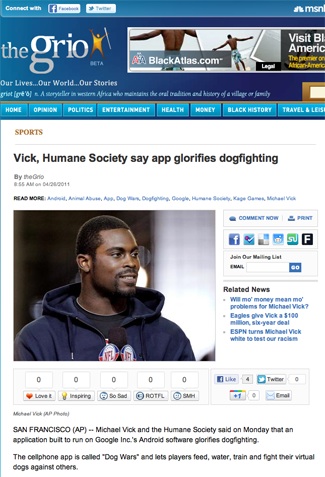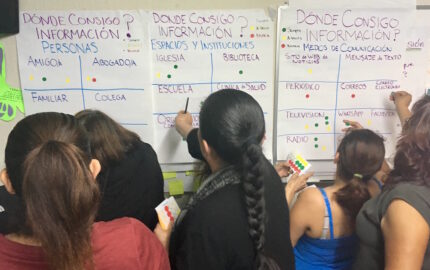Legacy news organizations have struggled for decades to widen their coverage to include people of color in all aspects of their lives. There are the ubiquitous A-list celebrities, of course, and the crossover musicians and the athletes, and those stories with an emotional punch that transcend the usual norms, but neither print nor broadcast media have consistently portrayed minorities in all facets of American life and culture.
I remember once telling a fellow editor that I had stopped reading a certain section of the paper because I so rarely saw my life or myself—a working black mother—represented in its stories or photographs. Through the years the excuses I heard for these lapses ranged from "we just didn't think about it" or "we didn't have anyone to send" to "there was no space" or "we had to make deadline."
But the Web is supposed to be different, right? Space is unlimited. The ability to aggregate copy gets around staffing concerns. The institutionalized habits (and excuses) that hamstrung the legacy newsrooms aren't part of online culture. Couple this with the notion that we're said to be living in a post-racial society and the result should be rich, vibrant reporting that represents the life experiences of all Americans. It should not be coverage that is stratified by class, race, geography, generation and gender.
At least that's what I expected to find in March when I embarked on a yearlong project for the Robert C. Maynard Institute for Journalism Education. My assignment was to examine the content of the homepages of eight websites once a day, Monday through Friday, with an eye toward diversity. Four sites—The Huffington Post, The Daily Beast, Slate and Salon—were selected to represent mainstream online media. (The word "mainstream" might seem a bit misplaced given its more common reference to legacy media, but for this comparison it makes sense.) Four others—The Root, theGrio, Loop21, and MarioWire—were chosen as minority online media.
Comparing the content of their stories in this way is not unlike what a similar exploration of newspapers might have looked like in the 1950's when black-owned papers still thrived in segregated America. Back then, the minority population was relatively miniscule and more separated in homes, neighborhoods and schools than today. According to the 2010 U.S. Census Bureau report, minorities are 36 percent of our population, with Hispanics being the largest group, followed by African Americans. With this percentage in mind, it seemed reasonable to believe more opportunities and motivation would exist for inclusive coverage—for stories and images that reflect people of color in all walks of life.
Yet inclusiveness is not what I've found. After several months of regular weekday screening, I can confirm that mainstream online media are caught in the same loop that ensnared legacy outlets. Their view of minorities is limited, and that in turn hinders their ability to broaden their coverage. The parallels between the legacies and online media are as stark as they are disheartening. Rather than fostering understanding that might help us find common ground, mainstream online media maintain the divisive "us vs. them" mentality that is evident in many of our contemporary conversations about race.
The Huffington Post's homepage, by far, features the greatest diversity of stories, followed by The Daily Beast, where too often the Beast's representation is little more than a link to a celebrity slideshow that includes minorities. Salon and Slate are hit and miss, but mostly miss. Although Slate links to its sister site, The Root, this tangential connection to diversity is stilted, and does little to promote understanding. African Americans are the minority most often covered on the homepage of these websites. When Hispanics appear, it is primarily in episodic stories about immigration. On most days it's a total miss for every other minority group.
Most of the stories focused on African Americans fall into one of three categories: A-list celebrity, person of influence, or athlete. Coverage of the crimes and misdemeanors of sports figures so dominates this space that it's clichéd. Even when a story might seem headed in a positive direction, the slide toward the negative seems almost inevitable. Tracking this was easy when the topic was Philadelphia Eagles quarterback Michael Vick.
In April, Vick, who had served jail time for his abuse of dogs, joined with the Humane Society in asserting that the Dog Wars phone app promoted dog fighting. Vick's decision offered an opportunity for a story about a good deed done simply for the doing—without payment or legal ramifications. The Huffington Post headlined The Associated Press story with this in mind. Above the article, however, appeared a menacing photo of Vick; my eyes were drawn to it immediately as it reminded me of the infamous Time cover of O.J. Simpson, his facial skin darkened for effect. In comparison, theGrio, using the same AP story that day, paired it with an image that showed him smiling.
In July, Nike re-signed Vick to an endorsement deal. Salon noted this with a post in support of Nike's decision. But its headline "Why Is Michael Vick Shilling for Nike?" likely left those scanning the page with a very different impression.


TheGrio and The Huffington Post published the same story about Philadelphia Eagles quarterback Michael Vick, yet the websites chose different photographs
Minority Websites
Generally, the four minority sites, particularly theGrio and The Root, provide more bicultural coverage in how they treat leading news stories of the day as well as enterprise stories they tell from an African-American perspective. They don't shy away from news of the day because African Americans aren't directly involved, though sometimes they frame events from a minority perspective. For example, The Root didn't bemoan the jury's verdict in Casey Anthony's acquittal; instead its post suggested that those wanting to reform the justice system should focus on matters such as racial profiling and incompetent counsel. Meanwhile, on the mainstream sites, debate raged on about whose acquittal was the bigger travesty—Simpson's or Anthony's.
RELATED ARTICLE
“Black Journalism Takes Root in Contemporary Times”
- Jack E. White The Web has provided a welcomed platform for minority viewpoints and opinions that had all but fallen silent after the civil rights movement prompted newsrooms to seek journalists of color. The Root, theGrio, MarioWire, and Loop21 give voice to stories and feature issues that might otherwise be ignored by the other news organizations or given not much more than the occasional glance. With their microphone aimed at amplifying minority points of view, these sites—well suited to the Web's fragmented niche environment—add valuable discourse on national issues
When Kobe Bryant spat out a gay slur during a Los Angeles Lakers game, Loop21 didn't question the decision by the National Basketball Association (NBA) to fine him or the criticism that he faced. What it posted was a piece in which its writer pondered the provocative issue of why NBA players faced fines for gay slurs, but not for using the N-word.
The stories on these minority-focused websites are similar to those that black and Hispanic journalists have long pitched with varying degrees of success in legacy newsrooms. With this in mind, it should surprise no one to learn that a number of prominent black journalists who worked in legacy media now work for non-mainstream digital media sites, including the four we looked at. And the stories they now do range from pieces on the stubbornly wide racial achievement gap to explorations of the varying medical treatment that doctors give people of different races and the consequences of these decisions. Even when their stories target specific groups and pop culture experiences, the attempt is made to frame them in ways that take into account a broader viewpoint.
These sites demonstrate—and in doing so challenge the mainstream online media to acknowledge—that there is a rich vein of stories waiting to be tapped. And this does not mean pulling back from controversy. Each of the four sites treats its readers to some of the strongest debate and criticism of the Obama administration being offered these days by writers who aren't conservatives. In March, Loop21 reported that it had been a year since the President met with the Congressional Black Caucus. Scathing remarks made by Princeton University professor Cornel West about President Obama's performance set off a chain of stories on Loop21 focused on this topic. The debate expanded beyond West's initial blast to a discussion of whether African Americans should even be critical of the first black president. MarioWire routinely gives space on its homepage to Latino commentators and activists frustrated with the administration's handling of immigration issues.
An argument could be made that the presence of these minority sites takes the burden off the mainstream to be more diverse and to reach for a broader audience. But just the opposite is true. Adding these voices to the mainstream conversation would make the national dialogue that much richer and genuine, just as leaving them out makes it hollow.
Jean Marie Brown is a former news executive at the Star-Telegram in Fort Worth, Texas with more than 20 years of experience in journalism; her areas of expertise include diversity and leadership in management. She is a graduate student at Texas Christian University's Schieffer School of Journalism.
I remember once telling a fellow editor that I had stopped reading a certain section of the paper because I so rarely saw my life or myself—a working black mother—represented in its stories or photographs. Through the years the excuses I heard for these lapses ranged from "we just didn't think about it" or "we didn't have anyone to send" to "there was no space" or "we had to make deadline."
But the Web is supposed to be different, right? Space is unlimited. The ability to aggregate copy gets around staffing concerns. The institutionalized habits (and excuses) that hamstrung the legacy newsrooms aren't part of online culture. Couple this with the notion that we're said to be living in a post-racial society and the result should be rich, vibrant reporting that represents the life experiences of all Americans. It should not be coverage that is stratified by class, race, geography, generation and gender.
At least that's what I expected to find in March when I embarked on a yearlong project for the Robert C. Maynard Institute for Journalism Education. My assignment was to examine the content of the homepages of eight websites once a day, Monday through Friday, with an eye toward diversity. Four sites—The Huffington Post, The Daily Beast, Slate and Salon—were selected to represent mainstream online media. (The word "mainstream" might seem a bit misplaced given its more common reference to legacy media, but for this comparison it makes sense.) Four others—The Root, theGrio, Loop21, and MarioWire—were chosen as minority online media.
Comparing the content of their stories in this way is not unlike what a similar exploration of newspapers might have looked like in the 1950's when black-owned papers still thrived in segregated America. Back then, the minority population was relatively miniscule and more separated in homes, neighborhoods and schools than today. According to the 2010 U.S. Census Bureau report, minorities are 36 percent of our population, with Hispanics being the largest group, followed by African Americans. With this percentage in mind, it seemed reasonable to believe more opportunities and motivation would exist for inclusive coverage—for stories and images that reflect people of color in all walks of life.
Yet inclusiveness is not what I've found. After several months of regular weekday screening, I can confirm that mainstream online media are caught in the same loop that ensnared legacy outlets. Their view of minorities is limited, and that in turn hinders their ability to broaden their coverage. The parallels between the legacies and online media are as stark as they are disheartening. Rather than fostering understanding that might help us find common ground, mainstream online media maintain the divisive "us vs. them" mentality that is evident in many of our contemporary conversations about race.
The Huffington Post's homepage, by far, features the greatest diversity of stories, followed by The Daily Beast, where too often the Beast's representation is little more than a link to a celebrity slideshow that includes minorities. Salon and Slate are hit and miss, but mostly miss. Although Slate links to its sister site, The Root, this tangential connection to diversity is stilted, and does little to promote understanding. African Americans are the minority most often covered on the homepage of these websites. When Hispanics appear, it is primarily in episodic stories about immigration. On most days it's a total miss for every other minority group.
Most of the stories focused on African Americans fall into one of three categories: A-list celebrity, person of influence, or athlete. Coverage of the crimes and misdemeanors of sports figures so dominates this space that it's clichéd. Even when a story might seem headed in a positive direction, the slide toward the negative seems almost inevitable. Tracking this was easy when the topic was Philadelphia Eagles quarterback Michael Vick.
In April, Vick, who had served jail time for his abuse of dogs, joined with the Humane Society in asserting that the Dog Wars phone app promoted dog fighting. Vick's decision offered an opportunity for a story about a good deed done simply for the doing—without payment or legal ramifications. The Huffington Post headlined The Associated Press story with this in mind. Above the article, however, appeared a menacing photo of Vick; my eyes were drawn to it immediately as it reminded me of the infamous Time cover of O.J. Simpson, his facial skin darkened for effect. In comparison, theGrio, using the same AP story that day, paired it with an image that showed him smiling.
In July, Nike re-signed Vick to an endorsement deal. Salon noted this with a post in support of Nike's decision. But its headline "Why Is Michael Vick Shilling for Nike?" likely left those scanning the page with a very different impression.


TheGrio and The Huffington Post published the same story about Philadelphia Eagles quarterback Michael Vick, yet the websites chose different photographs
Minority Websites
Generally, the four minority sites, particularly theGrio and The Root, provide more bicultural coverage in how they treat leading news stories of the day as well as enterprise stories they tell from an African-American perspective. They don't shy away from news of the day because African Americans aren't directly involved, though sometimes they frame events from a minority perspective. For example, The Root didn't bemoan the jury's verdict in Casey Anthony's acquittal; instead its post suggested that those wanting to reform the justice system should focus on matters such as racial profiling and incompetent counsel. Meanwhile, on the mainstream sites, debate raged on about whose acquittal was the bigger travesty—Simpson's or Anthony's.
RELATED ARTICLE
“Black Journalism Takes Root in Contemporary Times”
- Jack E. White The Web has provided a welcomed platform for minority viewpoints and opinions that had all but fallen silent after the civil rights movement prompted newsrooms to seek journalists of color. The Root, theGrio, MarioWire, and Loop21 give voice to stories and feature issues that might otherwise be ignored by the other news organizations or given not much more than the occasional glance. With their microphone aimed at amplifying minority points of view, these sites—well suited to the Web's fragmented niche environment—add valuable discourse on national issues
When Kobe Bryant spat out a gay slur during a Los Angeles Lakers game, Loop21 didn't question the decision by the National Basketball Association (NBA) to fine him or the criticism that he faced. What it posted was a piece in which its writer pondered the provocative issue of why NBA players faced fines for gay slurs, but not for using the N-word.
The stories on these minority-focused websites are similar to those that black and Hispanic journalists have long pitched with varying degrees of success in legacy newsrooms. With this in mind, it should surprise no one to learn that a number of prominent black journalists who worked in legacy media now work for non-mainstream digital media sites, including the four we looked at. And the stories they now do range from pieces on the stubbornly wide racial achievement gap to explorations of the varying medical treatment that doctors give people of different races and the consequences of these decisions. Even when their stories target specific groups and pop culture experiences, the attempt is made to frame them in ways that take into account a broader viewpoint.
These sites demonstrate—and in doing so challenge the mainstream online media to acknowledge—that there is a rich vein of stories waiting to be tapped. And this does not mean pulling back from controversy. Each of the four sites treats its readers to some of the strongest debate and criticism of the Obama administration being offered these days by writers who aren't conservatives. In March, Loop21 reported that it had been a year since the President met with the Congressional Black Caucus. Scathing remarks made by Princeton University professor Cornel West about President Obama's performance set off a chain of stories on Loop21 focused on this topic. The debate expanded beyond West's initial blast to a discussion of whether African Americans should even be critical of the first black president. MarioWire routinely gives space on its homepage to Latino commentators and activists frustrated with the administration's handling of immigration issues.
An argument could be made that the presence of these minority sites takes the burden off the mainstream to be more diverse and to reach for a broader audience. But just the opposite is true. Adding these voices to the mainstream conversation would make the national dialogue that much richer and genuine, just as leaving them out makes it hollow.
Jean Marie Brown is a former news executive at the Star-Telegram in Fort Worth, Texas with more than 20 years of experience in journalism; her areas of expertise include diversity and leadership in management. She is a graduate student at Texas Christian University's Schieffer School of Journalism.



